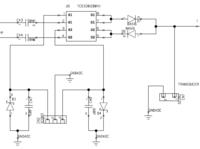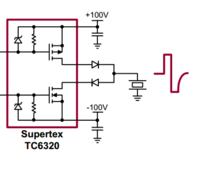jimmykk
Full Member level 3
N and P channel complementary Mosfets output waveform deviating from desired response
Hi
I am trying to make a pulse using circuits MD1213 and TC6320. The outputs obtained at drain terminals of MOSFET(TC6320) pair is not coming out as expected.i.e. basically the last negative cycle of the pulse takes a lot of time to return to zero(as shown in fig. CAHNNEL 3). I have provided voltages of +/-30V to source terminals of TC6320 and frequency of pulse is 50Khz. What could be the cause of this deviation and how it can be overcome.

Hi
I am trying to make a pulse using circuits MD1213 and TC6320. The outputs obtained at drain terminals of MOSFET(TC6320) pair is not coming out as expected.i.e. basically the last negative cycle of the pulse takes a lot of time to return to zero(as shown in fig. CAHNNEL 3). I have provided voltages of +/-30V to source terminals of TC6320 and frequency of pulse is 50Khz. What could be the cause of this deviation and how it can be overcome.


